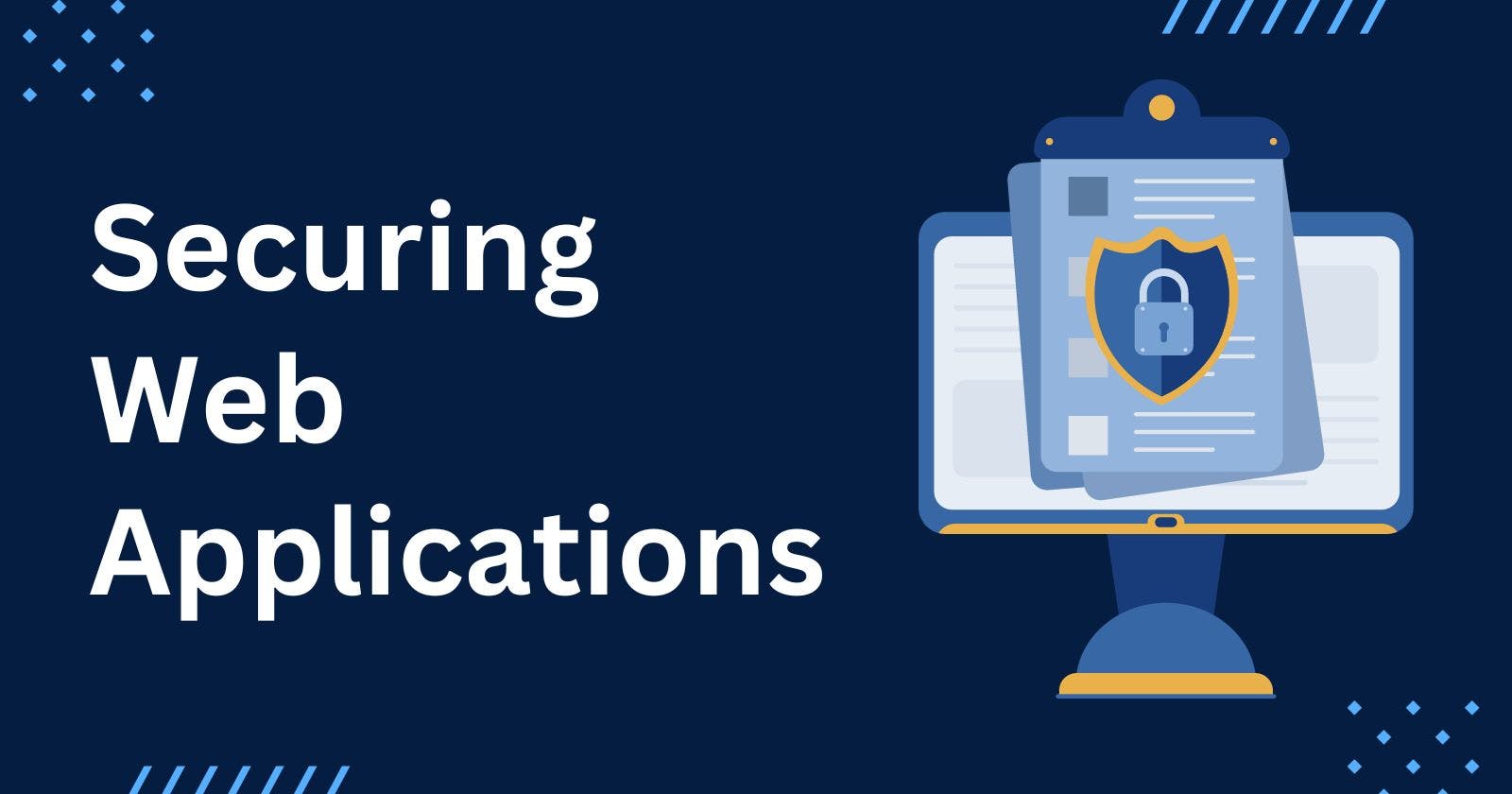Securing Web Applications: Identifying and Mitigating Common Vulnerabilities
In today's digital world, web applications have become an important part of our lives, facilitating online banking systems, e-commerce platforms, social media networks, and many other services we use daily. However, the rise of web applications has also led to an increase in cybercrime and hacking incidents.
Without proper protection, web applications can be vulnerable to attacks, causing data breaches, unauthorized access, and financial loss. Understanding web application security and implementing effective measures is essential to prevent these attacks and protect users' data. By prioritizing security, we can build trust with users, ensuring they feel safe sharing their information.
Table of Content
- What is Web Application Security?
- Common Web Application Vulnerabilities - OWASP Top 10
- Injection
- Insecure Design
- Broken Access Control
- Cryptographic Failures
- Security Misconfiguration
- Server-Side Request Forgery (SSRF)
- Vulnerable and Outdated Components
- Software and Data Integrity Failures
- Security Logging and Monitoring Failures
- Identification and Authentication Failures
- Conclusion
What is Web Application Security?
Web application security is a part of information security that keeps websites, web applications, and other web services safe. It involves taking measures to protect these applications from potential threats, vulnerabilities, and unauthorized access. The main goal of web application security is to detect and mitigate attacks that could compromise the security or functionality of web applications.
Common Web Application Vulnerabilities - OWASP Top 10
With cyber-attacks on the rise, it is essential to understand common vulnerabilities of web applications and how to mitigate them. The Open Web Application Security Project (OWASP), an open-source community dedicated to improving web application security, provides valuable insights through its OWASP Top 10 list. This list highlights the most dominant web application security risks and best practices to mitigate them. Let's explore these vulnerabilities and learn how to prevent them:
Injection
Injection vulnerabilities occur when malicious code or commands are injected into the input fields of a web application, allowing attackers to manipulate the system. SQL injection is a common injection that lets attackers exploit poorly written database queries to gain unauthorized access.
Another type of injection is cross-site scripting (XSS), where attackers insert client-side scripts into a website to access important information or perform undesirable actions. Other types of injection include command injection, LDAP injection, code injection, and cross-site request forgery.
How to Prevent Injection Vulnerabilities
Validate and sanitize user input, ensuring it matches the expected format and removing any harmful characters and script. Make use of frameworks and libraries that offer this functionality.
Use parameterized queries or prepared statements when interacting with databases, and avoid building queries with concatenated user input. This will help to prevent SQL injection attacks by separating the query structure from the user input.
Escape and encode data correctly when displaying it on web pages, as this will guard against cross-site scripting (XSS) attacks.
Opt for parameterized APIs or APIs that completely avoid interpreters. You can also use tools that offer object-relational mapping to improve security.
Regularly perform security testing, such as penetrative testing and code reviews, to detect and fix any vulnerabilities in your application.
Keep your web application and all its dependencies updated with the latest security patches and fixes. Make sure to review all updates before installation.
Insecure Design
Insecure design is a vulnerability that arises from the flaws in the architecture or design of a system. When security is not considered during the design phase, even the best security measures may not be effective. This leaves the system vulnerable to attacks that can cause system compromise or data breaches.
How to Prevent Insecure Design
Establish a secure development lifecycle with multiple security controls.
Prioritize threat modeling for access control, core flow, and application logic. Also, perform risk assessments to identify threats and implement necessary mitigation techniques.
Conduct regular penetration testing from the source code and database to the back-end network.
Stay informed about the latest security updates and create security awareness among your development team.
Broken Access Control
Broken access control, also known as inadequate authorization, is a vulnerability that occurs when authorization controls are not implemented properly. This can allow unauthorized access to sensitive data, account compromise, and damage to application availability, integrity, and confidentiality.
How to Prevent Broken Access Control
Perform comprehensive authorization checks and validations on all requests or actions.
Apply safe coding practices. Implement strong password management and identity verification.
Use secure session management techniques to prevent session hijacking or data leakage.
Monitor and audit access logs regularly and ensure all access control failures are logged and reported to administrators promptly.
Limit access to APIs and controllers to minimize the impact of automated attacks.
Instead of granting users permission to view, modify, or delete data, consider implementing a role-based access control (RBAC) model.
Cryptographic Failures
Cryptographic failures, formerly known as sensitive data exposure, occur when cryptographic algorithms or protocols are not implemented correctly. This can lead to exposure of sensitive information such as passwords, credit card details, or proprietary business secrets. Common examples of cryptographic failures include misuse of hashing algorithms, weak encryption algorithms, and poor key management.
How to Prevent Cryptographic Failures
When transferring sensitive data, use modern and secure protocols like Secure File Transfer Protocol (SFTP) and Hypertext Transfer Protocol Secure (HTTPS).
Use strong and adaptive hashing algorithms such as PBKDF2 or Script to store passwords securely.
Rather than using simple encryption, opt for authenticated encryption.
When generating keys, use cryptographically random bytes to create strong keys.
Update cryptographic libraries and systems regularly.
Security Misconfiguration
Security misconfiguration happens when safety protocols are not configured correctly, leaving your system vulnerable to attacks. It's similar to leaving a window unlocked or forgetting to set up a password for your Wi-Fi network, leaving you open to unwanted guests.
How to Prevent Security Misconfiguration
Synchronize development, operational, and QA environments for consistent security settings.
Follow security best practices when deploying applications, servers, or cloud services.
Create a solid platform by removing unnecessary features, components, and services.
Harden default configurations to mitigate vulnerabilities.
Document and maintain a secure baseline configuration for all your systems.
Server-Side Request Forgery (SSRF)
Server-Side Request Forgery (SSRF) is a dangerous cyber exploit that tricks a server into sending malicious requests. An attacker can use this vulnerability to bypass access controls, gain unauthorized access to sensitive information, or even take control of the server. Due to its ability to exploit the server's trust, SSRF can even penetrate robust security controls like firewalls and VPNs.
How to Prevent SSRF
Configure the firewall to deny all incoming web traffic by default and only allow necessary internal traffic.
Use network segmentation to isolate different segments and reduce the spread of breaches.
Secure API endpoints with proper authentication, authorization, and input validation.
Stay vigilant and question the legitimacy of any URLs you encounter to avoid being redirected to malicious domains and protect against "time of check, time of use" situations.
Vulnerable and Outdated Components
Vulnerable and outdated components refer to software, frameworks, libraries, and plugins that are out-of-date or known to have security vulnerabilities. Using such components increases the risk of security breaches. It's like having an important part of your fortress made of weaker materials, leaving an entry point for attackers.
How to Prevent Outdated Components Vulnerabilities
Always obtain components from trusted and official sources.
Use automated dependency management tools to track, manage, and update the dependencies.
Get rid of unnecessary features, files, and directories to make it easier to identify vulnerable components.
Stay up-to-date with security updates and patches. Apply them promptly to keep your system protected.
Software and Data Integrity Failures
Software and data integrity failures occur when software or data is corrupted, altered, or deleted without authorization. This vulnerability often happens in web applications that obtain resources from untrusted sources. When these resources are compromised, it can lead to unauthorized access, loss of data and functionality, and malicious code execution.
How to Prevent Software and Data Integrity Failures
Ensure that data and software sources are trusted and digitally signed.
Set up robust access controls and segmentation in your CI/CD workflow to secure your code.
Validate your data and use checksums to verify its integrity. Use strong checks and hash values for critical data.
Implement version control to track code changes and digital signatures to verify software package integrity.
Security Logging and Monitoring Failures
Security logging and monitoring failures happen when a system's logging or monitoring features don't function properly, making it difficult to detect security incidents. Without adequate logging, monitoring, or reporting, a web application can become an open target for attackers.
How to Prevent Logging and Monitoring Failures
Log all critical information like access security and authentication details, and include sufficient user information to identify suspicious accounts. Store the logs long enough to conduct any necessary investigations.
Generate logs in a standard format for streamlined management and analysis.
Implement a robust recovery and incident response strategy (like NIST 800-61r2) to reduce the impact of security issues.
Set up proper monitoring, alerting, and notifications to quickly detect and address security incidents.
Encrypt log data to protect against cyber threats. Regularly review and analyze logs for anomalies and suspicious activities.
Identification and Authentication Failures
Identification and authentication failures occur when a system does not verify the identity or credentials of users. This can lead to serious security incidents like data leaks, password cracking, and prolonged sessions caused by poorly set timeouts.
How to Prevent Authentication Failures
Use multi-factor authentication (MFA) for an extra layer of security. This can be done by asking users to provide multiple verifications, such as a password and a temporary code sent to their mobile device.
Implement strong password rules that combine numbers, symbols, and uppercase and lowercase letters.
Encourage users to create unique, complex passwords and to change them periodically.
Secure your sessions by setting an appropriate session timeout and password security in your database. Always invalidate sessions after logging out.
While the OWASP Top 10 is a valuable resource, it's important to remember that it does not encompass everything. The list primarily emphasizes server-side security, while many attacks target the client side. Therefore, you need to take a more comprehensive approach. The OWASP Top 10 is a good starting point, but you should supplement it with additional strategies based on your specific needs.
Conclusion
While software application development has become more secure over time, attackers are constantly looking for new ways to exploit weaknesses. To keep your web applications secure, following industry best practices and staying up to date on the latest cyber threats is essential.
It's also important to have a plan in place to quickly detect and respond to security incidents. Don't forget to educate your team about the best practices for web application security to prevent accidental security breaches. If you lack the resources to handle these in-house, you may consider outsourcing to a managed security service provider.

